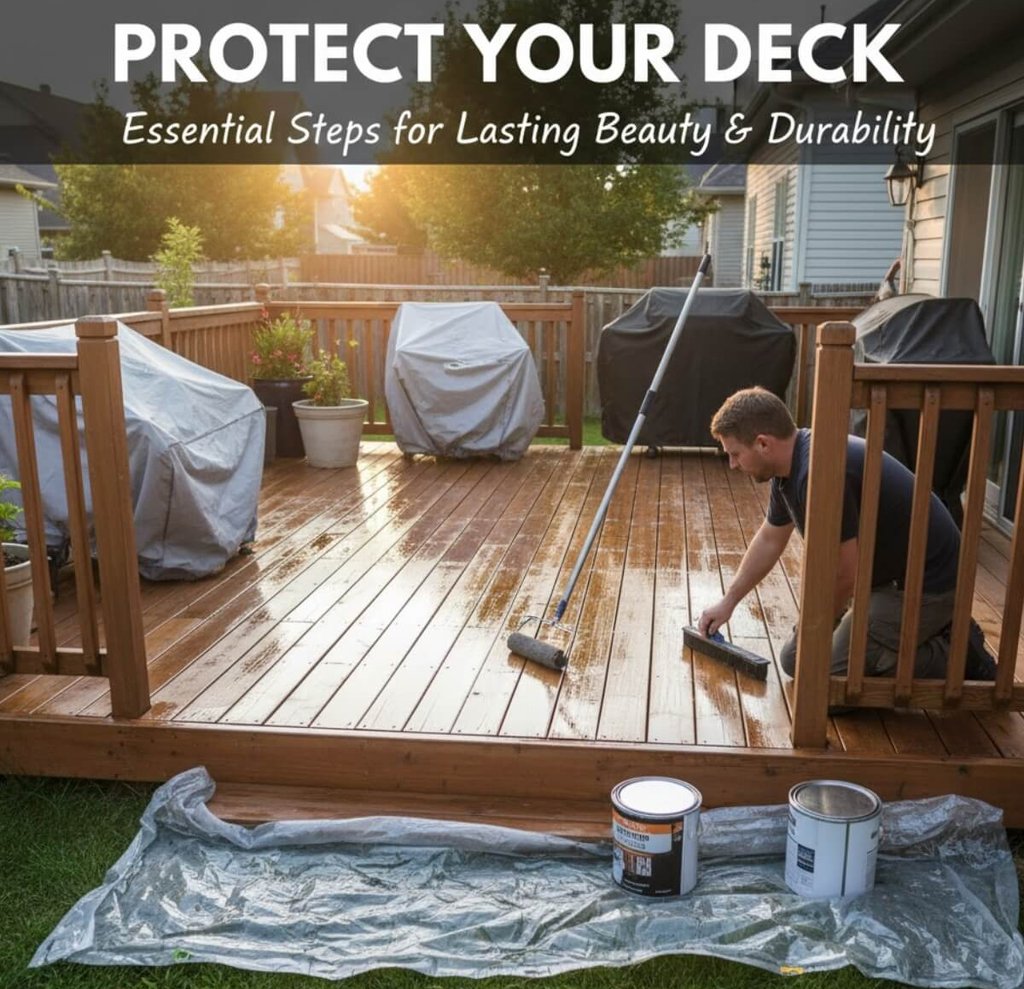How to Protect a Deck: Essential Tips for Long-Lasting Durability
Learn how to protect a deck with simple, proven tips that boost durability and prevent damage. Keep your deck strong for years—discover expert advice now!
11/14/20255 min read


A long-lasting deck isn’t an accident; it’s the result of smart material choices, good water management, steady maintenance, and a few simple habits. This article breaks those essentials into practical steps you can apply right away—whether you’re caring for a newer deck or extending the life of one that’s been outdoors for years.
Choose Materials and Hardware That Resist Decay
Pick The Correct Treated-wood Use Category
If your deck uses pressure-treated lumber, match each component to the right Use Category so it can survive its exposure. Boards that shed water and dry quickly are typically “Above Ground” (UC3B), while parts that touch soil, splash zones, or stay wet longer (like posts, ledgers exposed to splashback, and low framing) often require “Ground Contact” (UC4A). The end tag on each piece identifies the category. Verify it before installation or replacement.
Use Corrosion-Resistant Fasteners And Connectors
Moisture plus preservative chemicals can speed up metal corrosion. To prevent hidden failures at joists, hangers, and ledgers, use hot-dip galvanized steel (meeting common hot-dip standards) or stainless steel fasteners and connectors, and avoid mixing metals (for example, stainless screws with galvanized hangers) to reduce galvanic corrosion.
Understand How Treated Wood Affects Metals
Modern preservative systems (such as ACQ and CA) are more corrosive to unprotected steel than older formulas. Research has shown faster corrosion on bare or lightly coated fasteners embedded in treated wood under high humidity, reinforcing the need for robust coatings or stainless steel.
Keep Water Moving Off and Away
Flash The Ledger And Protect The House Interface
If your deck connects to the house, the ledger is a critical moisture point. Remove siding at the attachment zone, install approved corrosion-resistant flashing, and seal as detailed in deck construction guidance to keep water out of the wall assembly. Proper flashing with drip edge is required at ledger connections to wood-framed walls.
Detail Edges And Transitions To Shed Water
Use metal drip edges and thoughtful sequencing at edges, stairs, and railing posts so water drains off components, not into them. Maintain a small gap behind ledgers or use spacers/washers where recommended to promote drainage and drying along the wall interface.
Encourage Airflow And Drying
Decks last longer when they dry quickly. Provide ventilation below the framing (especially for low decks), leave consistent gaps between deck boards, and avoid solid skirting that traps humidity unless it’s vented. The goal is simple: let wet wood dry evenly and fast.
Manage Grade And Site Drainage
Standing water near posts and footings shortens a deck’s life. Ensure surrounding hard surfaces slope away from the building at about 2% so runoff doesn’t wash back under the deck or against the house.
Seal, Stain, and Maintain the Surface
Choose Penetrating Finishes Over Film-forming Coats
For horizontal walking surfaces, penetrating finishes (water-repellent preservatives, lightly pigmented WRPs, or semitransparent oil-based stains) outperform paints and heavy film-forming coatings. They soak in, don’t peel, and are easier to renew. Pigment improves UV resistance and service life compared with clear water-repellent products.
Clean Gently And Safely
Before finishing, clean the surface to remove dirt, mildew, and weathered fibers. Gentle methods are best: avoid aggressive pressure-washing that erodes soft spring wood. A diluted liquid household-bleach solution (about 1 part bleach to 3 parts water) can remove mildew. Never mix bleach with ammonia, and rinse thoroughly. Allow at least a couple of warm, breezy days for drying before applying the finish.
Re-Coat On A Realistic Schedule
Expect clear water-repellent treatments to need yearly renewal on exposed walking surfaces; semitransparent oil-based stains typically last longer thanks to their pigments and penetrating binders. Staying ahead of finish failure prevents checks, raised grain, and decay from getting started.
Seal End Grain And Fresh Cuts
Moisture wicks fastest through end grain. Whenever you trim deck boards or cut new posts/rails, treat freshly exposed ends with a compatible preservative or water-repellent product to slow water uptake and reduce cracking.
Smart Construction and Usage Details That Add Years
Prioritize Robust Connections
At joists, beams, and ledgers, follow prescriptive fastening layouts and use corrosion-resistant hardware sized for the loads. Tight, correctly spaced through-bolts or lag screws at the ledger, plus approved hangers, help the structure resist movement that can open pathways for water.
Keep Hardware Out Of Permanent Wet Zones
Where components are hard to replace or likely to stay wet (close to grade, next to sprinklers, or in splash areas), step up protection: choose the higher use category for wood and the most corrosion-resistant fasteners and connectors your budget allows. This reduces both decay risk and metal loss over time.
Reduce Debris Traps
Gaps that allow water and small debris to fall through are helpful, but maintenance still matters. Sweep leaves and soil off the deck and out of board gaps, and lift planters or mats onto risers so the surface below can breathe. Consistent airflow and a clean surface break the cycle of wetting and staying wet.
Be Mindful Of Winter Care
Ice-melt products containing chlorides and persistent wetness can accelerate hardware corrosion; minimize their use near metal connections and rinse residues when possible. Clearing snow promptly and gently helps your finish last longer and reduces water loading during freeze-thaw cycles.
Seasonal Inspection Checklist
Spring Check (After The Wet Season)
Probe suspect spots (posts at bases, stair stringers, ledger area) for softwood.
Look for hairline cracks that hold water; renew the finish where color and water beading are fading.
Verify that flashing is intact and shedding water correctly.
Mid-season Touch-ups
Tighten loose fasteners before movement enlarges holes.
Clean high-traffic areas and shaded zones prone to mildew, then spot-treat with a compatible product.
Fall Prep (Before Winter)
Clear debris from gaps and under the deck to restore airflow.
Confirm site drainage sends water away from the footing line; regrade or add drains if needed.
Common Mistakes to Avoid
Trapping Moisture With The Wrong Finish
Film-forming coatings on walking surfaces tend to peel and trap water beneath; choose penetrating finishes instead.
Mixing Dissimilar Metals
Don’t pair stainless fasteners with galvanized hangers (or vice versa). Keep metals consistent to reduce galvanic corrosion.
Skipping Ledger Flashing
Ledger areas are frequent failure points. Proper flashing and sealing are not optional—treat them as essential water-control details.
Keep Your Deck Strong and Enjoyable
Protecting a deck is about staying ahead of water: selecting wood and hardware that tolerate wetting, detailing every junction to shed moisture, letting the structure dry quickly, and renewing a penetrating finish on a sensible cycle. Add steady housekeeping —clearing debris, inspecting connections, and managing runoff —and you’ll extend service life, safety, and appearance for years. If you want expert help applying these best practices or restoring a weathered surface the right way, Redrra is ready to plan, service, and maintain your deck so it looks great and lasts longer.
FAQs About How to Protect a Deck
How Often Should I Re-Coat My Deck?
Horizontal surfaces typically need yearly renewal with clear water-repellent treatments; semitransparent stains last longer but still require periodic maintenance as UV and foot traffic wear them down.
What Kind Of Fasteners Should I Use With Treated Wood?
Use hot-dip galvanized or stainless steel fasteners and connectors, and avoid mixing metals to reduce galvanic corrosion.
Do I Really Need Flashing On The Ledger?
Yes. Approved corrosion-resistant flashing is required where the ledger meets a wood-framed wall to prevent water from entering the house assembly.
How Can I Reduce Decay At Posts And Low Framing?
Choose the correct treated-wood Use Category (often UC4A for parts near soil or splash zones), maintain airflow beneath the deck, and direct runoff away from footings.
What’s The Safest Way To Clean Mildew?
After a dry-out period, use gentle cleaning methods. A diluted household-bleach solution can remove mildew. Never mix bleach with ammonia, and rinse thoroughly before refinishing.
Your Home, Your Vision, Our Expertise.
Transforming Spaces with Unmatched Craftsmanship
© 2025. All rights reserved.
Proudly Serving Seattle & King County
Bellevue
Redmond
Bothell
Renton
Issaquah
Sammamish
Kenmore
Seattle
Kirkland
Shoreline
Mercer Island
Woodinville
Newcastle
…and many more across King County!
